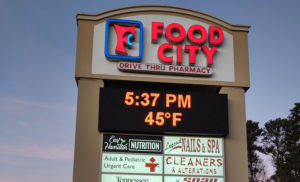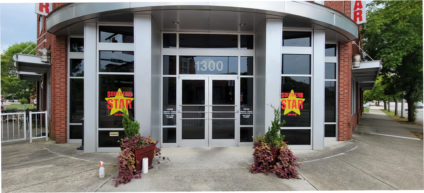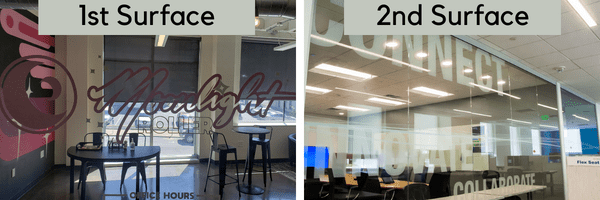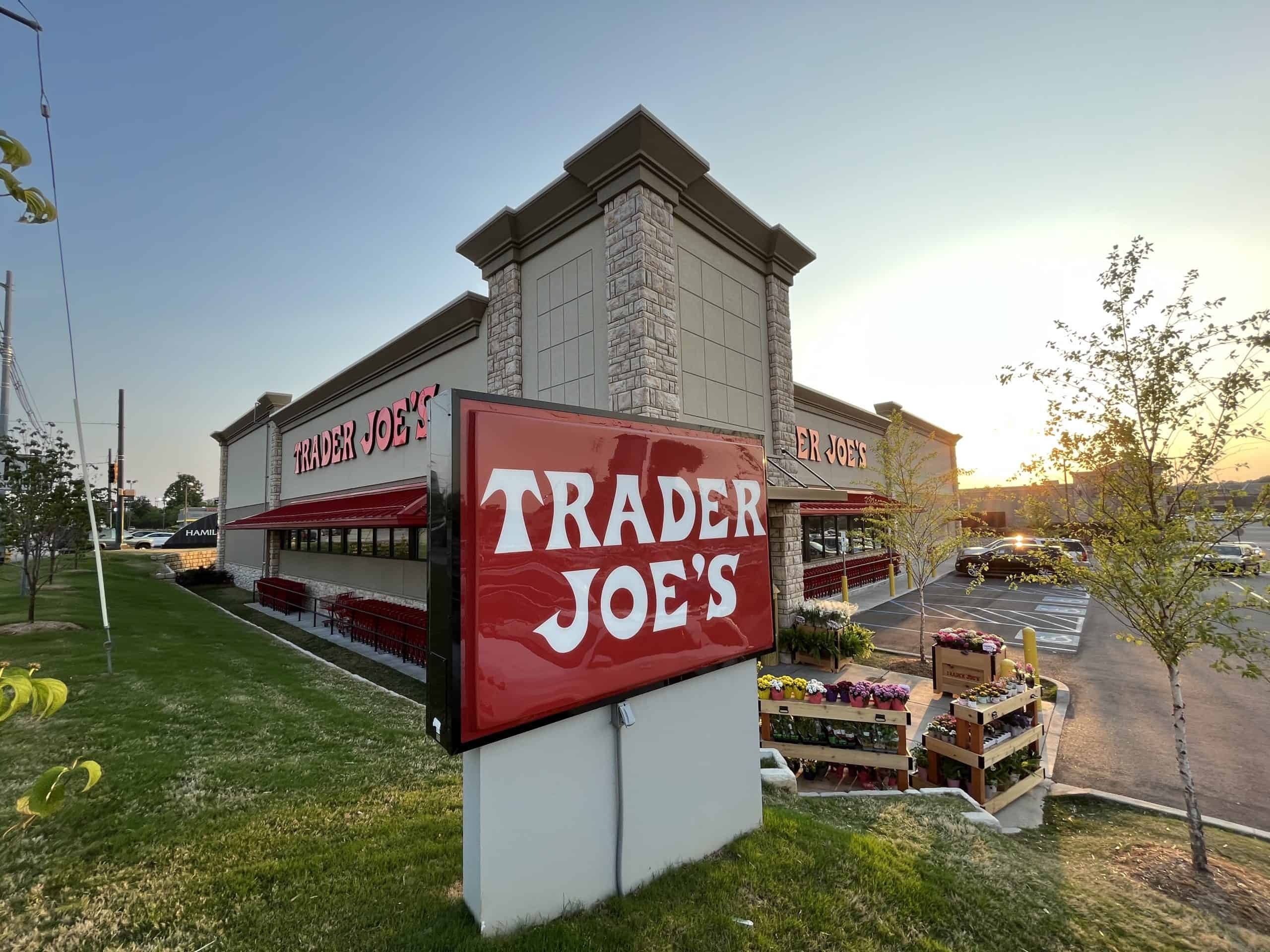For many the term vinyl may evoke music records and LPs; however, for those of us in the sign industry when we think of vinyl we think of all the uses for the malleable plastic that is vinyl. That can include everything from window applications, sign faces, awnings, and more! Vinyl’s versatility is why its presence seems nearly ubiquitoss in our industry. In this blog we discuss how vinyl came to be, why it’s so popular, and we’ll highlight its many uses in the signage industry.
What is Vinyl?
Vinyl is a synthetic material composed of chlorine and ethylene. When these are chemically bonded, they form polyvinyl chloride (PVC), a durable and versatile plastic.
When was Vinyl discovered?
According to Thoughtco.com’s History of Vinyl, German chemist Eugen Baumann invented polyvinyl chloride, aka PVC, in 1872. Since then it’s become the 2nd most produced type of plastic in the world, and it’s become a boon for the sign industry and businesses alike. Vinyl has a great many applications, whether it be for car wraps, exterior signage, interior signage, or first or second surface printing. Today we discuss how we at Ortwein Sign use vinyl, the uses of vinyl, how it’s applied, and how it’s already likely impacting your business signage.
How did Vinyl become a key component of Business Signs, Church Signs, School Signs, and Interior and Exterior Signage in general?
As we and many other sign companies moved away from our origins as a hand-painting sign company, we began to embrace vinyl as a faster, cheaper option for applying logos and designs to a myriad of sign types. Though the materials and initial infrastructure to have a vinyl shop costs some investment, compared to the type and costs of hand painting over time, the move has saved companies and customers money. The advancements in computers and digital printers helped speed up this transformation even faster.
Now vinyl is one of the most ubiquitous materials used in signage.
When was Vinyl first used for signage?
According to 3M’s article “Vinyl: A History” in Signs of the Times Magazine, the first use of vinyl on signage was in Minnesota in the late 1930s when it was applied as a reflective coating to roadside signage.
What are the most common uses of vinyl in the sign industry?
Vinyl is commonly used in various sign types, including:
- Flex Face & Pan Face Signs
- ACM Signs
- Window Graphics (First-surface and Second-surface vinyl)
- Channel Letters
What Sign Types Incorporate Vinyl?
Vinyl is so ubiquitous that this may not be an exhaustive list of all of its uses in signage; however, these are many of the types of signs that often incorporate vinyl.
Channel Letters
A standard channel letter is a three-dimensional sign element commonly used for eye-catching displays. The letter’s structure, or “channel,” is usually crafted from sheet metal, typically aluminum, which is chosen for its rust-resistant properties. The process begins with cutting a flat aluminum sheet, often done with a computer-controlled router, to form the back of the letter and define its shape. Afterward, the letter can is painted and equipped with lighting elements like neon tubes or LED modules. When illuminated at night, these letters effectively capture the attention of passersby.
Pan Faces
Pan Face signs are plastic sign faces that are molded into a three-dimensional form, offering a cost-effective signage option. Their versatility and ability to be customized with brand elements make them one of the most popular choices, second only to Channel Letters in terms of widespread use.
Flex Faces
A Flex Face sign is made from a flexible material, typically a durable vinyl, that stretches over a frame. Unlike Pan Faces, Flex Faces are ideal for larger signs and are known for their ability to withstand various weather conditions without cracking or breaking.
Cloud Signs
Cloud signs are custom vinyl signs that mimic the appearance of connected, illuminated channel letters. Popular for storefronts, they offer an affordable signage option for businesses looking for impactful branding.
Window Signs
First-Surface Window Vinyl
First surface window vinyl is applied directly to the front or outer face of a material, such as the exterior of a glass window or door. This is the most common vinyl application, and it can help reduce glare that might otherwise reflect off the surface or pass through the glass.
Second-Surface Window Vinyl
Second surface window vinyl is applied to the inside or back of a glass surface. While less commonly used than first surface vinyl, it offers the advantage of being shielded from the elements, protecting it from weather exposure, external damage, or potential vandalism when used on outdoor windows or doors.
Vehicle Graphics and Wraps
Vehicle graphics and wraps consists of applying vinyl to either part or the whole of a vehicle’s body. This can be done to change the color of a vehicle or more often to add graphics or images to the vehicle. This can be done for personal vehicles or for commercial fleets.
Awnings
Awnings are often made out of vinyl and adorn doorfronts, windows, or entryways. The vinyl is usually held within metal frames. Logos or other graphics can often be applied to awnings as well.
Regulatory Signs
Regulatory Signs are non-illuminated road and street signs used to communicate important traffic rules and safety measures. Examples include Yield signs, Stop signs, and railroad crossing signs.
ACM Panels
ACM (Aluminum composite material) panels are layered signs with made of aluminum sheets and a polyethylene panel at the center.
What are the Different Types of Vinyl?
1. What is Wrap Vinyl?
A wrap vinyl is used for applying graphics to vehicles, whether that be personal cars or entire commercial fleets.

2. What is Cast Vinyl?
Cast vinyl has more polyester, and is more stretchable.
3. What is Translucent Vinyl?

Translucent vinyl is used for backlit signs, where the light needs to shine through the vinyl.
4. What is Opaque Vinyl?

Opaque can be used for a variety of functions, except where you might want light to shine through the vinyl.
5. What is Perforated Vinyl?
Perforated vinyl is a vinyl application that allows you to apply vinyl graphics that display the graphic to the outside while still allowing patrons inside your business to see out.
What is the Difference between First Surface and Second Surface Vinyl?

First surface is vinyl that is applied on to the face or front of the material, for example vinyl that’s applied on the front of a glass window or door. First surface is the most common application of vinyl, and its use can help prevent glares that would otherwise reflect on the shines through the glass.
Second surface is vinyl that is applied to the back or underneath of glass. Though it is less frequently used than first surface, when applied to an outside window or door it does have the advantage of separation from the outside elements and any external interference or any vandalism.
How Long Does Vinyl Last?
Vinyl’s age differs depending on where it’s placed, the elements, and if it comes into frequent contact with people or weather.
How Can I Increase the Age of My Vinyl?
While it’s not applicable for all scenarios, lamination will help preserve vinyl.

